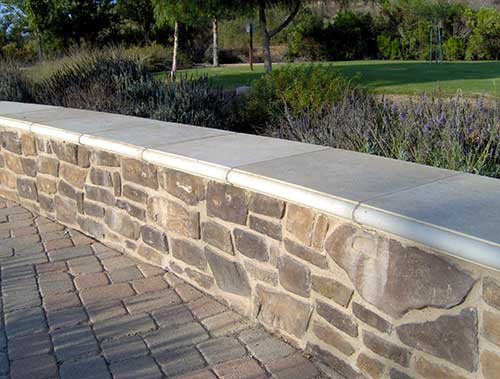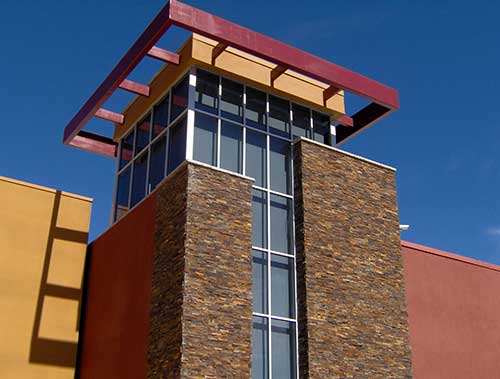Natural Modular Stone Systems: An Important Advancement in Mankind's First Building Material
Vulnerable Stone Surface
 |
When artificial stone is chipped, the cement interior is exposed and the stone aesthetic is destroyed. Artificial stones are also susceptible to effloresce, which causes a white powdery coating on the surface of the manufactured rock. Both chips and the effects of efflorescence are visible here. Photo courtesy Real Stone Source, LLC. |
Â
One significant weakness in artificial stone is the vulnerability of its stone surface. While this building material is molded to look like stone, the interior of the product is still a mixture of cement, aggregate and color pigments. This dual nature is easily exposed when the decorative surface chips, cracks, or breaks. The manufactured interior becomes visible and the stone aesthetic is destroyed.
These man-made, color-treated stone exteriors are more susceptible to outdoor wear and tear and chemical exposure than the natural stone after which they are modeled. The color of the stone may noticeably fade as it weathers or be discolored if it is treated with a chemical solvent. Artificial stone products are not recommended in areas with cascading waters, such as fountains and pools, and exposure to deicing salts can also cause damage to manufactured cement products.
This product is also predisposed to be affected by efflorescence, which causes a significant shift in the exterior color of the manufactured stone. Efflorescence is a naturally occurring process that affects all concrete when it is exposed to low temperatures, moist conditions, condensation, rain and dew. As soluble salts and other water dispersible materials leak from the concrete, it creates a powdery whiteness on the surface of the stone that can make the color appear faded. Â
Hard to Maintain
Unfortunately, the vulnerability of the artificial stone surface also makes it very difficult to maintain. In most cases, artificial stone may only be cleaned with a soft bristled brush and detergent. Anything more powerful: wire brushes, acid washes, power cleaners, bleach and other chemical solvents, including paint remover and concrete cleaner, can potentially discolor or disintegrate the product. This sensitivity to chemicals makes it difficult to remove paint or mortar that may have accidentally been applied to the surface during construction, or the powdery whiteness caused by efflorescence.Â
The weathering and wear that occurs on the surface of these products, also makes it difficult to repair individual stones, without damaging the overall uniformity of the system. When stones are cracked or chipped, and need to be replaced, the replacement stones will stand out in the system because of the differences in wear.
Artificial stone improved the production rate, color inconsistency, design challenges, and job costing ambiguities that plagued the traditional use of full-bed natural stone. Even with all of those improvements, artificial stone was still incapable of duplicating the natural aesthetic, durability, and ease of maintenance inherent in natural stone. Â Was it possible to have the best of both worlds?Â
Â
The New Stone Solution: Natural Modular Stone Systems
Â
 |
The Arroyo Market Square in Las Vegas (shown above) utilizes over 150,000 square feet of natural modular stone. This system pairs the beauty and durability of natural stone with the design consistency and production value of artificial stone. Photo courtesy Real Stone Source, LLC. |
Â
Natural modular stone systems are the solution that combines the beauty and durability of natural stone with the design consistency and production value of an artificial stone system. These systems take the original, natural stone and modify the traditional process of sending quarried stone directly to the job site. Instead, quarried stone is sent to an assembly house where the rock is organized into veneer panels or mats or other veneer accessories, like corner pieces. Those modular components are then sent to the project site for installation.









